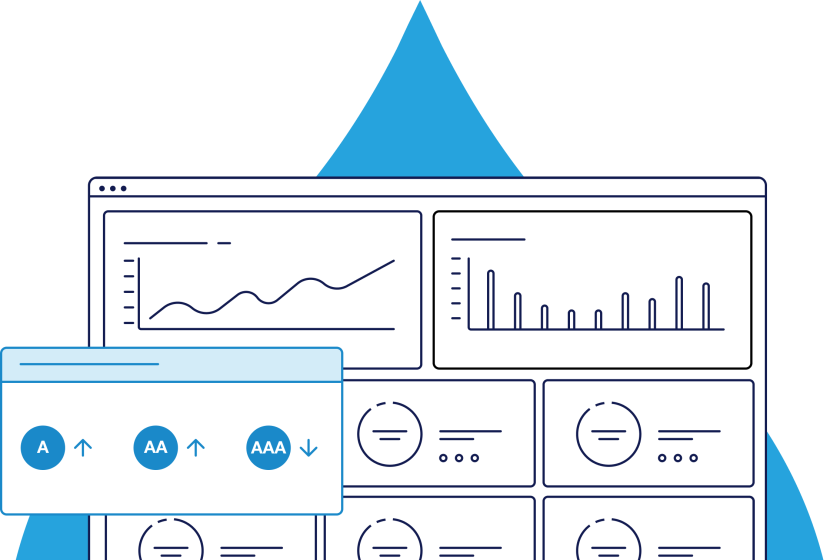2024 Survey Report
Consumer Perspectives on Digital Accessibility
Digital accessibility has become a business-critical topic due to legal requirements and its influence on customer experience. But is enough being done? Acquia commissioned a survey to understand how users with disabilities perceive the state of digital accessibility, and how their experiences impact brand perception and loyalty.

There is a growing recognition that digital accessibility is now a business imperative, not a nice-to-have. Expanding legal and regulatory requirements as well as increasing awareness of the impacts of digital accessibility on customer experience, brand reputation, and revenue are leading a push to embed accessibility as a central element in the design and delivery of digital experiences.
Many reports on the state of digital accessibility examine the perspectives of business leaders regarding compliance concerns and the organizational policies, structures, and resources in place to address digital accessibility. At Acquia, we wanted to understand the other side: how do users themselves – specifically, users with disabilities – perceive the state of digital accessibility? And what impacts do their experiences have on the organizations they interact with online?
To help answer these questions, Acquia commissioned ResearchScape to conduct an online survey examining the frequency and type of accessibility challenges that website users with disabilities encounter on websites and other digital experiences, and how these experiences affect brand perception and loyalty. Fielded in April 2024, ResearchScape’s online survey collected responses from 1,265 participants in the United States, Canada, United Kingdom, and Australia. Read on to see the results.
The Frequency & Kind of Accessibility Barriers Users Encounter
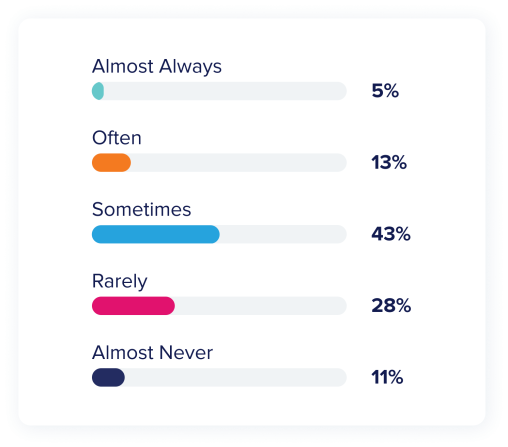
How often do you encounter accessibility issues that make it challenging to interact with websites or other digital experiences offered by brands?
89% of participants say they encounter accessibility issues that make it challenging to interact with websites or other digital experiences offered by brands. A total of 18% of survey participants report they encounter digital accessibility issues “often” (13%) or “almost always” (5%), while 43% report they “sometimes” encounter digital accessibility barriers. Only 11% of respondents say they “never” encounter accessibility issues that make it challenging to interact with websites.
Looking at the data in more detail, respondents who identify as male or female report that they encounter digital accessibility challenges at roughly the same rate of frequency. However, younger generations say they encounter digital accessibility issues more often. 25% of Millennial respondents and 36% of Gen Z respondents report encountering accessibility issues either “often” or “almost always”, compared to 16% of Boomers and 14% of the Gen X generation. Those with higher household income also report encountering accessibility issues with great frequency. 27% of those who report household income of $100K+ say they face accessibility issues “often” or “almost always”, compared to 16% for those in the $50-$99K bracket and 18% for those reporting household income under $50K.
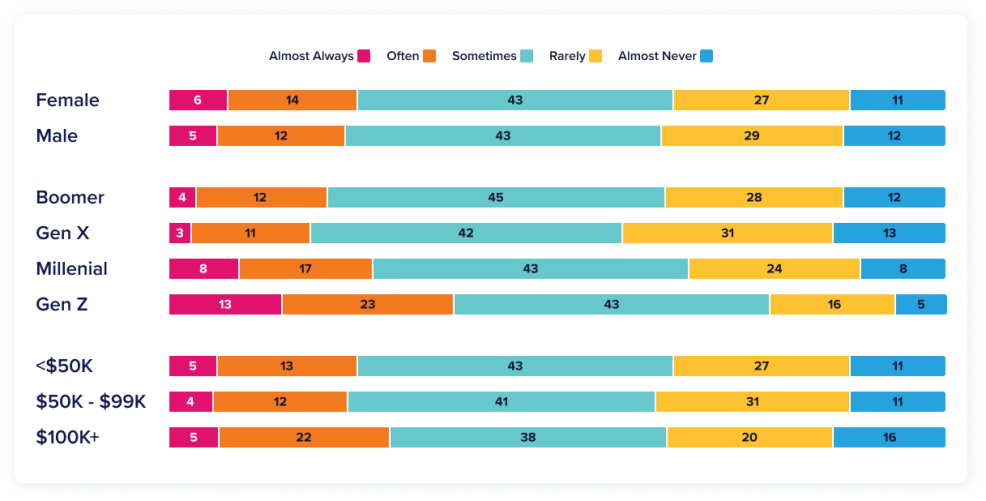

What types of accessibility challenges do you commonly face when using digital platforms or services?
Unfortunately, a variety of digital accessibility errors are pervasive in the experiences of survey participants. When asked to select one or more options for the challenges they commonly encounter when using digital platforms or services, respondents most often stated that they encounter inaccessible website design or layout (31%), followed by video/audio content without captions or transcripts and insufficient keyboard navigation options (both at 24%). Users also said they commonly encounter unlabeled form fields or buttons (21%), poor content contrast or color choices (20%), and lack of alternative text for images (19%).

How would you rate the level of frustration you experience when encountering accessibility issues on digital platforms or services offered by brands?
The number of accessibility challenges users with disabilities encounter is matched by the level of frustration those errors produce. Nearly half of respondents (45%) rate their level of frustration when encountering accessibility issues on digital platforms as either “very frustrating” or “extremely frustrating” (33% and 12%, respectively). 44% rate their experience as “somewhat frustrating”, while only 11% rate their experience as either “hardly” or “not at all” frustrating (7% and 4%, respectively).


93% of respondents say that it is important that the brands they engage with prioritize accessibility in their digital experiences.
The Consequences of Digital Accessibility Challenges

What emotions do you feel toward a brand when you encounter accessibility challenges on their website?
Not only are accessibility issues widespread, but so are the impacts. Aligned to the above, survey participants most commonly say they feel frustration toward a brand when they encounter accessibility challenges on its website (71%), while 58% say they feel disappointed and 24% feel angry. These were followed by feelings of being excluded (18%), unimportant (14%), indifferent (9%), and embarrassed (8%). In a particularly strong reaction, nearly 1 in 10 participants (7%) report feeling “contempt” toward a brand when they encounter accessibility challenges.
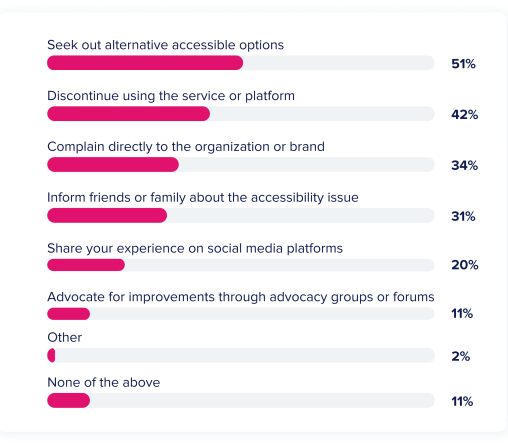
When you encounter accessibility issues while using digital platforms or services offered by brands, what actions are you most likely to take?
When asked what steps they are most likely to take when experiencing accessibility issues, 51% of respondents stated they would most likely seek alternative accessible options and 42% said that they would discontinue use of the brand’s services – directly impacting an organization’s bottom line. 34% said they would complain directly to the brand. However, nearly one-third (31%) said they would talk about the accessibility issue with their family and friends, while 20% would share their experience on social media – creating a ripple effect of negative brand perception that extends far beyond the users with disabilities who experience these problems first-hand.
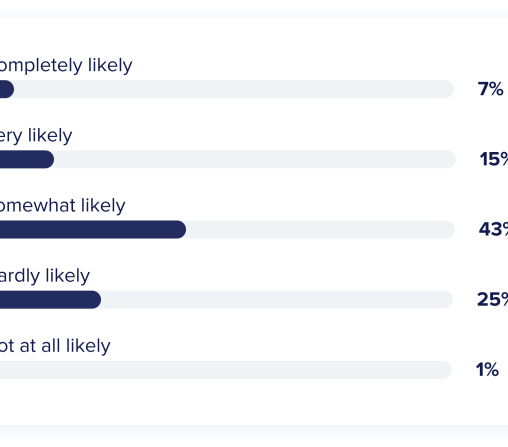
How likely are you to continue using the digital services or platforms of a brand or organization after encountering accessibility issues?
Brands who don’t prioritize digital accessibility face a substantial risk of losing their audience and, ultimately, customers. Only 7% of respondents say they are “completely likely” to continue using the digital services or platforms of a brand after encountering accessibility issues, and only 15% say they are “very likely.” A not-too-encouraging 43% say they are “somewhat likely” to keep using the brand’s digital services, while 26% say they are either “hardly” or “not at all” likely (25% and 1%, respectively).
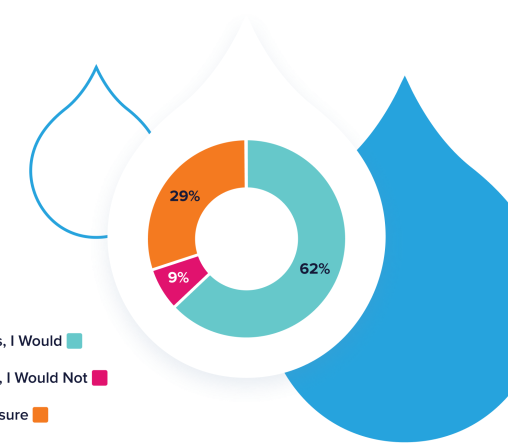
Would you consider switching to a competitor with better accessibility features if you constantly faced accessibility challenges with a particular brand’s digital platforms?
More than half (62%) of survey respondents say that they would consider switching to a competitor with better accessibility features if they constantly faced accessibility challenges with a particular brand’s digital platforms. 29% say they are unsure, but only 9% reported that they would remain loyal to a brand with persistent digital accessibility problems.
Looking at the data in more detail, respondents who identify as male more likely to switch to a competitor with better accessibility features (65% of males say they would switch and only 24% are unsure, versus 59% of females who say they would switch and 33% who say they are unsure). The generational differences are more pronounced, with younger generations significantly more willing to consider switching than their older counterparts (67% of Gen Z and 66% of Millennials say they would switch to a competitor, compared to 61% and 53% of Gen X and Boomer respondents, respectively). Household income appears to have little bearing on whether a user would switch to a competitor with better accessibility features; 60% or more of respondents in all three income brackets say they would switch to a competitor.
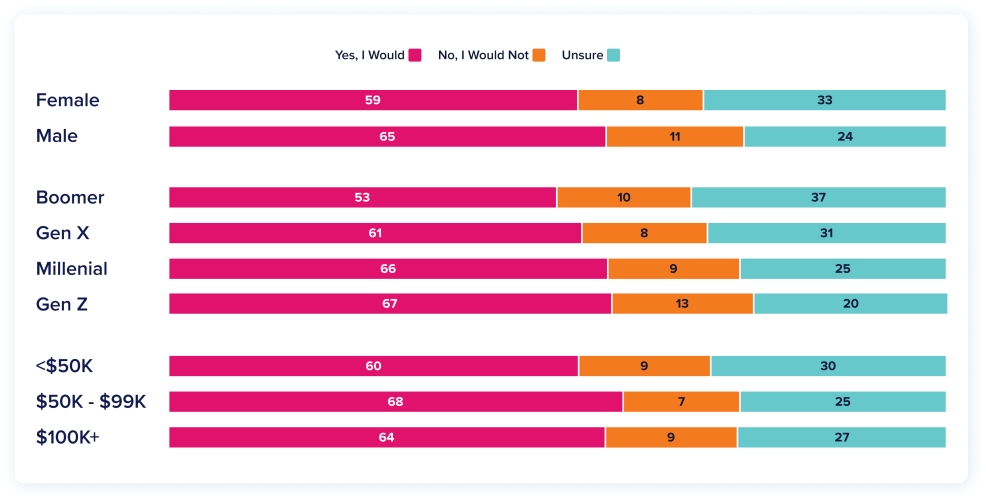
Belief in Forward Progress
In the past year, how would you generally categorize the action taken by companies to improve the accessibility of their digital experiences?
The survey participants’ experiences and perceptions clearly show that more work needs to be done to improve digital accessibility, and brands would be rewarded for taking decisive action. However, consumers want progress instead of platitudes and many respondents reported skepticism about companies’ true intentions. When looking at the past year, only 27% believe that companies are taking accessibility seriously and making meaningful improvements. 33% believe companies do the basics to check the regulatory compliance box, while 28% believe that companies talk about accessibility as a marketing tactic and little action has been taken. Meanwhile, 12% believe that companies aren’t thinking about or doing anything to improve digital accessibility.

Takeaways
The data is clear: digital accessibility challenges are widespread and, as a result, the digital experiences offered by many organizations often are not meeting the expectations of all of their customers. The hidden cost of failing to prioritize digital accessibility can be seen in reduced market reach, reduced loyalty, and negative brand reputation.
At Acquia, we know that digital accessibility is an essential pillar of digital experience design and management that should not be overlooked or shortchanged. Creating equal, accessible opportunities for all is a value all marketers and organizations should strive for. That’s why the Acquia DXP, including solutions such as the Acquia Web Governance platform, is built to prioritize inclusivity and empower web, digital, and marketing teams to deliver optimized and compliant digital experiences.
Web Accessibility Handbook
To learn more about how to start or expand your digital accessibility program, download your copy of Acquia’s Web Accessibility Handbook.
Get the Accessibility Handbook Explore Acquia's Web Governance Platform
